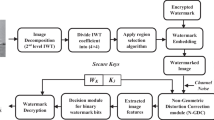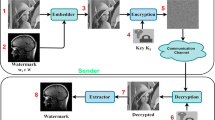Abstract
This article describes the basic information hiding technique that is most commonly used nowadays. As evolution in the communication media has made information access much easier but has also increased the risks of invading privacy and ownership. To overcome such threats, watermarking is one of the most suitable methods used for hiding information. It is the process of inserting audio, video, image or text for owner verification. A study on spatial and temporal domain watermarking is conducted. An experiment is carried out for the analysis of power and time consumption while inserting and extraction of the watermarks. For better understanding of the concept, embedding of an image on a video was performed using a computer and a mobile with similar logic. This concluded that the watermarking process can be implemented by both computer and mobile phones. Extraction of image was done with PSNR value that was inserted on a video. Only limitation found in this process was tracing back to the source of content theft and that is covered by forensic watermarking.








Similar content being viewed by others
References
Venugopala, P. S., Sarojadevi, H., & Chiplunkar, N. N. (2017). An approach to embed image in video as watermark using a mobile device. Sustainable Computing: Informatics and Systems, 15, 82–87.
Khan, A., Sohaib, M., & Amjad, F. M. (2016). High-capacity multi-layer framework for highly robust textual steganography. Science International, 28(5), 4451–4457.
Khan, A. (2015). Comparative analysis of watermarking techniques. Science International, 27(6), 6091–6096.
Zheng, Z., Saxena, N., Mishra, K. K., & Sangaiah, A. K. (2018). Guided dynamic particle swarm optimization for optimizing digital image watermarking in industry applications. Future Generation Computer Systems, 88, 92–106.
Khan, A. (2015). Robust Textual Steganography. Journal of Science, 4(4), 426–434.
Khan, A., & Sarfaraz, A. (2018). Copy/move forgery detection in MPEG videos used for personal communications. Wireless Personal Communications, 103(4), 2995–3008.
Khan, A. (2014). Joint ownership verification for digital text. Advances in Computer Science and its Applications (ACSA), 3(4), 525–531.
Singh, A. K., Kumar, B., Singh, S. K., Ghrera, S. P., & Mohan, A. (2016). Multiple watermarking technique for securing online social network contents using back propagation neural network. Future Generation Computer Systems, 86, 926–939.
Hameed, K., Khan, A., Ahmed, M., Reddy, A. G., & Rathore, M. M. (2018). Towards a formally verified zero watermarking scheme for data integrity in the Internet of Things based-wireless sensor networks. Future Generation Computer Systems, 82, 274–289.
Khan, A., & Sarfaraz, A. (2018). Novel high-capacity robust and imperceptible image steganography scheme using multi flipped permutations and frequency entropy matching method. Soft Computing. https://doi.org/10.1007/s00500-018-3441-1.
Sarfaraz, A., & Khan, A. (2018). Feature selection based correlation attack on HTTPS secure searching. Wireless Personal Communications, 103(4), 2995–3008.
Nayak, A. A., Venugopala, P. S., Sarojadevi, H., & Chiplunkar, N. N. (2014). A survey and comparative study on video watermarking techniques with reference to mobile devices. International Journal of Engineering Research and Applications, 4(12 (Part 6)), 39–44.
Wei- Meng, L. (2011). Beginning android application development. Hoboken: Wiely.
Suresh Kumar, M., & Madhavi Latha, G. (2014). DCT based secret image hiding in video sequence. International Journal of Engineering Research and Applications, 4(8(Version 1)), 5–9.
Haribabu, M., Bindu, C. H., & Swamy, K. V. (2016). A secure & invisible image watermarking scheme based on wavelet transform in HSI color space. Procedia Computer Science, 93, 462–468.
Gupta, A., Chandwani, A., & Yadav, G. (2014). RGB image watermarking on video frames using DWT. In Confluence the next generation information technology summit (confluence), 5th international conference, at Noida, on 25–26, (pp. 675–680).
Abraham, J., & Paul, V. (2016). An imperceptible spatial domain color image watermarking scheme. Journal of King Saud University-Computer and Information Sciences.
Siddiqui, A., & Kaur, A. (2017). A secure and robust image watermarking system using wavelet domain. In 2017 7th international conference on cloud computing, data science & engineering-confluence (pp. 599–604). IEEE.
Robert, A., & Doerr, G. (2013). Impact of content mastering on the throughput of a bit stream video watermarking system. In 2013 20th IEEE international conference on image processing (ICIP).
Khan, A., & Sarfaraz, A. (2018). Practical Guidelines for securing wireless local area networks (WLANs). International Journal of Security and Its Applications, 12(3), 19–28.
Khan, A., & Sarfaraz, A. (2017). Vetting the security of mobile applications. Science International, 29(2), 361–365.
Author information
Authors and Affiliations
Corresponding author
Additional information
Publisher's Note
Springer Nature remains neutral with regard to jurisdictional claims in published maps and institutional affiliations.
Rights and permissions
About this article
Cite this article
Noor, R., Khan, A. & Sarfaraz, A. High Performance and Energy Efficient Image Watermarking for Video Using a Mobile Device. Wireless Pers Commun 104, 1535–1551 (2019). https://doi.org/10.1007/s11277-018-6097-3
Published:
Issue Date:
DOI: https://doi.org/10.1007/s11277-018-6097-3




